Business Finance Report: Financial Analysis and Budgeting Strategies
VerifiedAdded on 2023/01/19
|13
|3238
|30
Report
AI Summary
This report provides a comprehensive overview of business finance, focusing on key concepts such as profit, cash flow, and working capital. It examines the differences between profit and cash flow, and delves into the components of working capital, including receivables, inventory, and payables. The report then applies these concepts to a case study, analyzing a company's financial performance, including its profit margins, debt levels, and working capital management. It offers recommendations for improving cash flow through effective management of accounts receivable, inventory, and accounts payable. Furthermore, the report explores different budgeting methods, including incremental, rolling, zero-based, and activity-based budgeting, highlighting their pros and cons and their application in controlling business operations and financial resources. The report emphasizes the importance of financial planning and strategic decision-making to enhance profitability and operational efficiency.

Business Finance
Paraphrase This Document
Need a fresh take? Get an instant paraphrase of this document with our AI Paraphraser


Table of Contents
EXECUTIVE SUMMARY.............................................................................................................1
PART 1 ...........................................................................................................................................1
EXECUTIVE SUMMARY.............................................................................................................1
PART B............................................................................................................................................1
1) Main objective of preparing budgets.......................................................................................1
2) Application of different budgets..............................................................................................2
3) Examination of alternative several budgetary system.............................................................3
CONCLUSION................................................................................................................................3
REFERENCERS .............................................................................................................................5
EXECUTIVE SUMMARY.............................................................................................................1
PART 1 ...........................................................................................................................................1
EXECUTIVE SUMMARY.............................................................................................................1
PART B............................................................................................................................................1
1) Main objective of preparing budgets.......................................................................................1
2) Application of different budgets..............................................................................................2
3) Examination of alternative several budgetary system.............................................................3
CONCLUSION................................................................................................................................3
REFERENCERS .............................................................................................................................5
⊘ This is a preview!⊘
Do you want full access?
Subscribe today to unlock all pages.

Trusted by 1+ million students worldwide

Paraphrase This Document
Need a fresh take? Get an instant paraphrase of this document with our AI Paraphraser
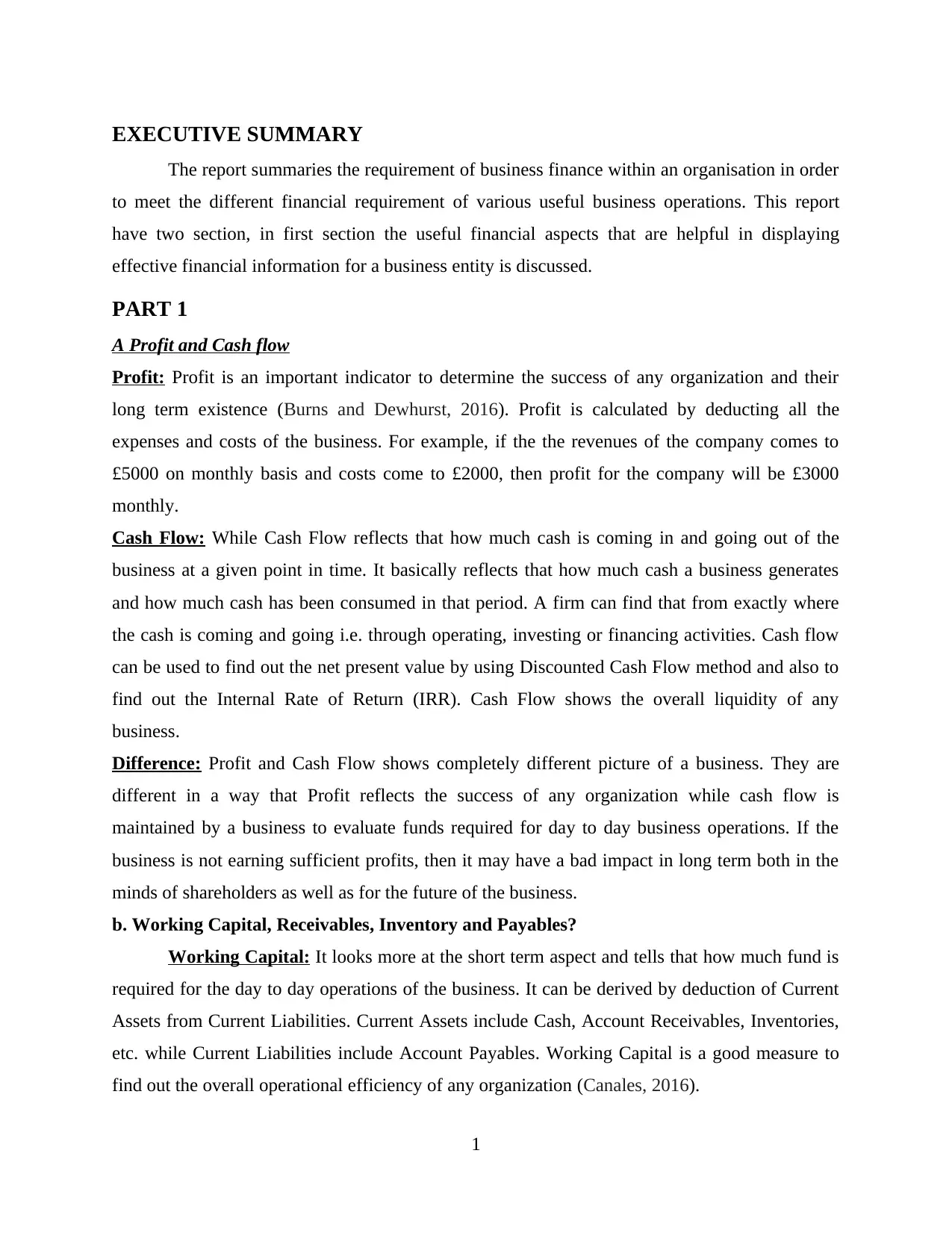
EXECUTIVE SUMMARY
The report summaries the requirement of business finance within an organisation in order
to meet the different financial requirement of various useful business operations. This report
have two section, in first section the useful financial aspects that are helpful in displaying
effective financial information for a business entity is discussed.
PART 1
A Profit and Cash flow
Profit: Profit is an important indicator to determine the success of any organization and their
long term existence (Burns and Dewhurst, 2016). Profit is calculated by deducting all the
expenses and costs of the business. For example, if the the revenues of the company comes to
£5000 on monthly basis and costs come to £2000, then profit for the company will be £3000
monthly.
Cash Flow: While Cash Flow reflects that how much cash is coming in and going out of the
business at a given point in time. It basically reflects that how much cash a business generates
and how much cash has been consumed in that period. A firm can find that from exactly where
the cash is coming and going i.e. through operating, investing or financing activities. Cash flow
can be used to find out the net present value by using Discounted Cash Flow method and also to
find out the Internal Rate of Return (IRR). Cash Flow shows the overall liquidity of any
business.
Difference: Profit and Cash Flow shows completely different picture of a business. They are
different in a way that Profit reflects the success of any organization while cash flow is
maintained by a business to evaluate funds required for day to day business operations. If the
business is not earning sufficient profits, then it may have a bad impact in long term both in the
minds of shareholders as well as for the future of the business.
b. Working Capital, Receivables, Inventory and Payables?
Working Capital: It looks more at the short term aspect and tells that how much fund is
required for the day to day operations of the business. It can be derived by deduction of Current
Assets from Current Liabilities. Current Assets include Cash, Account Receivables, Inventories,
etc. while Current Liabilities include Account Payables. Working Capital is a good measure to
find out the overall operational efficiency of any organization (Canales, 2016).
1
The report summaries the requirement of business finance within an organisation in order
to meet the different financial requirement of various useful business operations. This report
have two section, in first section the useful financial aspects that are helpful in displaying
effective financial information for a business entity is discussed.
PART 1
A Profit and Cash flow
Profit: Profit is an important indicator to determine the success of any organization and their
long term existence (Burns and Dewhurst, 2016). Profit is calculated by deducting all the
expenses and costs of the business. For example, if the the revenues of the company comes to
£5000 on monthly basis and costs come to £2000, then profit for the company will be £3000
monthly.
Cash Flow: While Cash Flow reflects that how much cash is coming in and going out of the
business at a given point in time. It basically reflects that how much cash a business generates
and how much cash has been consumed in that period. A firm can find that from exactly where
the cash is coming and going i.e. through operating, investing or financing activities. Cash flow
can be used to find out the net present value by using Discounted Cash Flow method and also to
find out the Internal Rate of Return (IRR). Cash Flow shows the overall liquidity of any
business.
Difference: Profit and Cash Flow shows completely different picture of a business. They are
different in a way that Profit reflects the success of any organization while cash flow is
maintained by a business to evaluate funds required for day to day business operations. If the
business is not earning sufficient profits, then it may have a bad impact in long term both in the
minds of shareholders as well as for the future of the business.
b. Working Capital, Receivables, Inventory and Payables?
Working Capital: It looks more at the short term aspect and tells that how much fund is
required for the day to day operations of the business. It can be derived by deduction of Current
Assets from Current Liabilities. Current Assets include Cash, Account Receivables, Inventories,
etc. while Current Liabilities include Account Payables. Working Capital is a good measure to
find out the overall operational efficiency of any organization (Canales, 2016).
1
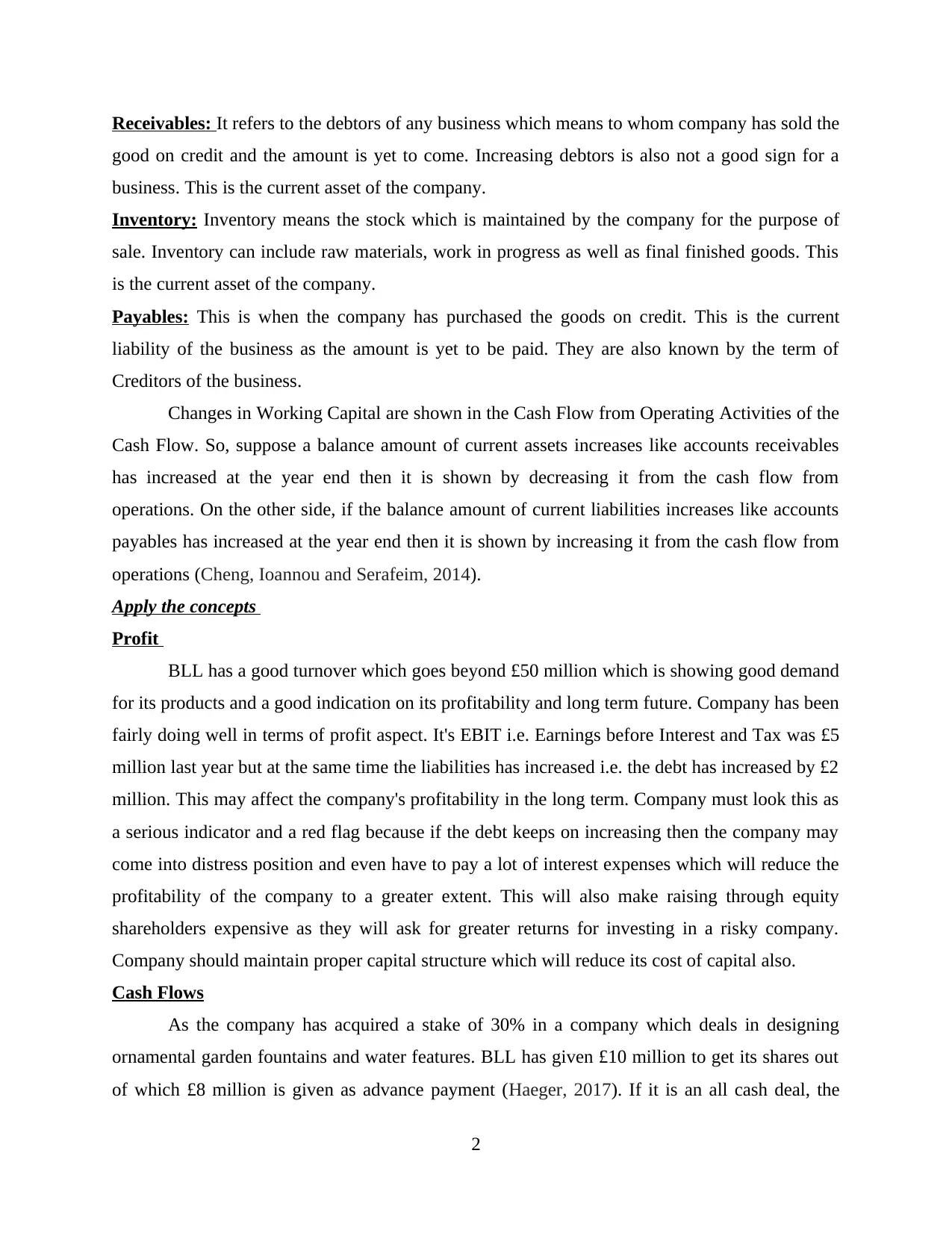
Receivables: It refers to the debtors of any business which means to whom company has sold the
good on credit and the amount is yet to come. Increasing debtors is also not a good sign for a
business. This is the current asset of the company.
Inventory: Inventory means the stock which is maintained by the company for the purpose of
sale. Inventory can include raw materials, work in progress as well as final finished goods. This
is the current asset of the company.
Payables: This is when the company has purchased the goods on credit. This is the current
liability of the business as the amount is yet to be paid. They are also known by the term of
Creditors of the business.
Changes in Working Capital are shown in the Cash Flow from Operating Activities of the
Cash Flow. So, suppose a balance amount of current assets increases like accounts receivables
has increased at the year end then it is shown by decreasing it from the cash flow from
operations. On the other side, if the balance amount of current liabilities increases like accounts
payables has increased at the year end then it is shown by increasing it from the cash flow from
operations (Cheng, Ioannou and Serafeim, 2014).
Apply the concepts
Profit
BLL has a good turnover which goes beyond £50 million which is showing good demand
for its products and a good indication on its profitability and long term future. Company has been
fairly doing well in terms of profit aspect. It's EBIT i.e. Earnings before Interest and Tax was £5
million last year but at the same time the liabilities has increased i.e. the debt has increased by £2
million. This may affect the company's profitability in the long term. Company must look this as
a serious indicator and a red flag because if the debt keeps on increasing then the company may
come into distress position and even have to pay a lot of interest expenses which will reduce the
profitability of the company to a greater extent. This will also make raising through equity
shareholders expensive as they will ask for greater returns for investing in a risky company.
Company should maintain proper capital structure which will reduce its cost of capital also.
Cash Flows
As the company has acquired a stake of 30% in a company which deals in designing
ornamental garden fountains and water features. BLL has given £10 million to get its shares out
of which £8 million is given as advance payment (Haeger, 2017). If it is an all cash deal, the
2
good on credit and the amount is yet to come. Increasing debtors is also not a good sign for a
business. This is the current asset of the company.
Inventory: Inventory means the stock which is maintained by the company for the purpose of
sale. Inventory can include raw materials, work in progress as well as final finished goods. This
is the current asset of the company.
Payables: This is when the company has purchased the goods on credit. This is the current
liability of the business as the amount is yet to be paid. They are also known by the term of
Creditors of the business.
Changes in Working Capital are shown in the Cash Flow from Operating Activities of the
Cash Flow. So, suppose a balance amount of current assets increases like accounts receivables
has increased at the year end then it is shown by decreasing it from the cash flow from
operations. On the other side, if the balance amount of current liabilities increases like accounts
payables has increased at the year end then it is shown by increasing it from the cash flow from
operations (Cheng, Ioannou and Serafeim, 2014).
Apply the concepts
Profit
BLL has a good turnover which goes beyond £50 million which is showing good demand
for its products and a good indication on its profitability and long term future. Company has been
fairly doing well in terms of profit aspect. It's EBIT i.e. Earnings before Interest and Tax was £5
million last year but at the same time the liabilities has increased i.e. the debt has increased by £2
million. This may affect the company's profitability in the long term. Company must look this as
a serious indicator and a red flag because if the debt keeps on increasing then the company may
come into distress position and even have to pay a lot of interest expenses which will reduce the
profitability of the company to a greater extent. This will also make raising through equity
shareholders expensive as they will ask for greater returns for investing in a risky company.
Company should maintain proper capital structure which will reduce its cost of capital also.
Cash Flows
As the company has acquired a stake of 30% in a company which deals in designing
ornamental garden fountains and water features. BLL has given £10 million to get its shares out
of which £8 million is given as advance payment (Haeger, 2017). If it is an all cash deal, the
2
⊘ This is a preview!⊘
Do you want full access?
Subscribe today to unlock all pages.

Trusted by 1+ million students worldwide

company's cash may deplete enormously but it may also increase the company's debt even more
because no company generally pay all the cash on their own. It is generally financed by debt
only. Already the company has huge debt, and this may worsen the situations. But M&A has its
own benefits for the companies. It may help the company to increase its profitability in the long
run and enhance the growth of the company is the acquisition has done very strategically after
looking at all the synergies.
Working Capital
Now, the company is struggling to get out of a legal case due to which the company's
money is blocked and this is again impact its profitability. As both C&P and BricoFrance has not
yet paid for the consignments, so accounts receivables has increased for the company by £3.5
million i.e. (£1.5 million of C&P and £2 million of BricoFrance). Too much Accounts
Receivables may increase the current assets for the company but it is not a good indication as the
chances of debtors not making the payments increases. So, this a serious concern and may
impact the financials of the company badly (Jordà, Schularick and Taylor, 2016).
C. Analysis and recommendation
BLL is already struggling a lot in the matters of managing its working capital properly
i.e. its Current Assets and Current Liabilities. They need to take some urgent actions to manage
and increase their operational efficiency as well as liquidity. So, to improve the company's cash
flow, the company need to focus upon the key areas of Working Capital: Accounts Receivables,
Inventory and Accounts Payables. Recommendations on improving the cash flow through
working capital management are:
1. Revamping the collections from accounts receivables or debtors: BLL has two
accounts receivables i.e. C&P and BricoFrance which owes up to £3.5 million. Company
should take immediate actions to get this money back either by motivating them through
new incentives. It is mentioned in the case that the company does not take nay actions
and is very reluctant to put pressure on their main customers for giving the payments
(Hou, Van Dijk and Zhang, 2012). But, this needs to be changed on a very serious note as
this is impacting their cash flows a lot.
2. Meeting the debt payments on time and evaluate interest expenses: As the company
has too much obligations in terms of debt, some measures have to be taken to reduce it.
3
because no company generally pay all the cash on their own. It is generally financed by debt
only. Already the company has huge debt, and this may worsen the situations. But M&A has its
own benefits for the companies. It may help the company to increase its profitability in the long
run and enhance the growth of the company is the acquisition has done very strategically after
looking at all the synergies.
Working Capital
Now, the company is struggling to get out of a legal case due to which the company's
money is blocked and this is again impact its profitability. As both C&P and BricoFrance has not
yet paid for the consignments, so accounts receivables has increased for the company by £3.5
million i.e. (£1.5 million of C&P and £2 million of BricoFrance). Too much Accounts
Receivables may increase the current assets for the company but it is not a good indication as the
chances of debtors not making the payments increases. So, this a serious concern and may
impact the financials of the company badly (Jordà, Schularick and Taylor, 2016).
C. Analysis and recommendation
BLL is already struggling a lot in the matters of managing its working capital properly
i.e. its Current Assets and Current Liabilities. They need to take some urgent actions to manage
and increase their operational efficiency as well as liquidity. So, to improve the company's cash
flow, the company need to focus upon the key areas of Working Capital: Accounts Receivables,
Inventory and Accounts Payables. Recommendations on improving the cash flow through
working capital management are:
1. Revamping the collections from accounts receivables or debtors: BLL has two
accounts receivables i.e. C&P and BricoFrance which owes up to £3.5 million. Company
should take immediate actions to get this money back either by motivating them through
new incentives. It is mentioned in the case that the company does not take nay actions
and is very reluctant to put pressure on their main customers for giving the payments
(Hou, Van Dijk and Zhang, 2012). But, this needs to be changed on a very serious note as
this is impacting their cash flows a lot.
2. Meeting the debt payments on time and evaluate interest expenses: As the company
has too much obligations in terms of debt, some measures have to be taken to reduce it.
3
Paraphrase This Document
Need a fresh take? Get an instant paraphrase of this document with our AI Paraphraser

Interest expenses should be made on timely basis to reduce more penalties. Evaluating
interest payments improve a lot on the working capital of the company.
3. Inventory Management: As the company was facing a dispute of around £1.5 million, it
has already closed its operations in one of the site temporarily and a large amount of
inventory has been developed on the site located in London. After the dispute gets
resolved, the company has to again maintain the inventory level. So, company must focus
upon its inventory to improve its cash flow and working capital.
4. Monitoring the Accounts Payables: BLL should also consider that how much creditors
the company have right now and should make the strategies to clear the due as soon as
possible and do not delay it. Proper record should be maintained about the deadlines and
avoid late payments.
5. Resolving disputes with Suppliers and Customers: The company is suffering from
some legal cases, so it should take care that in future there are no such kind of disputes
with the suppliers as well as the customers. If the cases are resolved on a timely manner,
it will improve a lot on the cash flows of BLL and operational efficiency will also
increase with proper working capital management (Sassen, 2017).
4
interest payments improve a lot on the working capital of the company.
3. Inventory Management: As the company was facing a dispute of around £1.5 million, it
has already closed its operations in one of the site temporarily and a large amount of
inventory has been developed on the site located in London. After the dispute gets
resolved, the company has to again maintain the inventory level. So, company must focus
upon its inventory to improve its cash flow and working capital.
4. Monitoring the Accounts Payables: BLL should also consider that how much creditors
the company have right now and should make the strategies to clear the due as soon as
possible and do not delay it. Proper record should be maintained about the deadlines and
avoid late payments.
5. Resolving disputes with Suppliers and Customers: The company is suffering from
some legal cases, so it should take care that in future there are no such kind of disputes
with the suppliers as well as the customers. If the cases are resolved on a timely manner,
it will improve a lot on the cash flows of BLL and operational efficiency will also
increase with proper working capital management (Sassen, 2017).
4
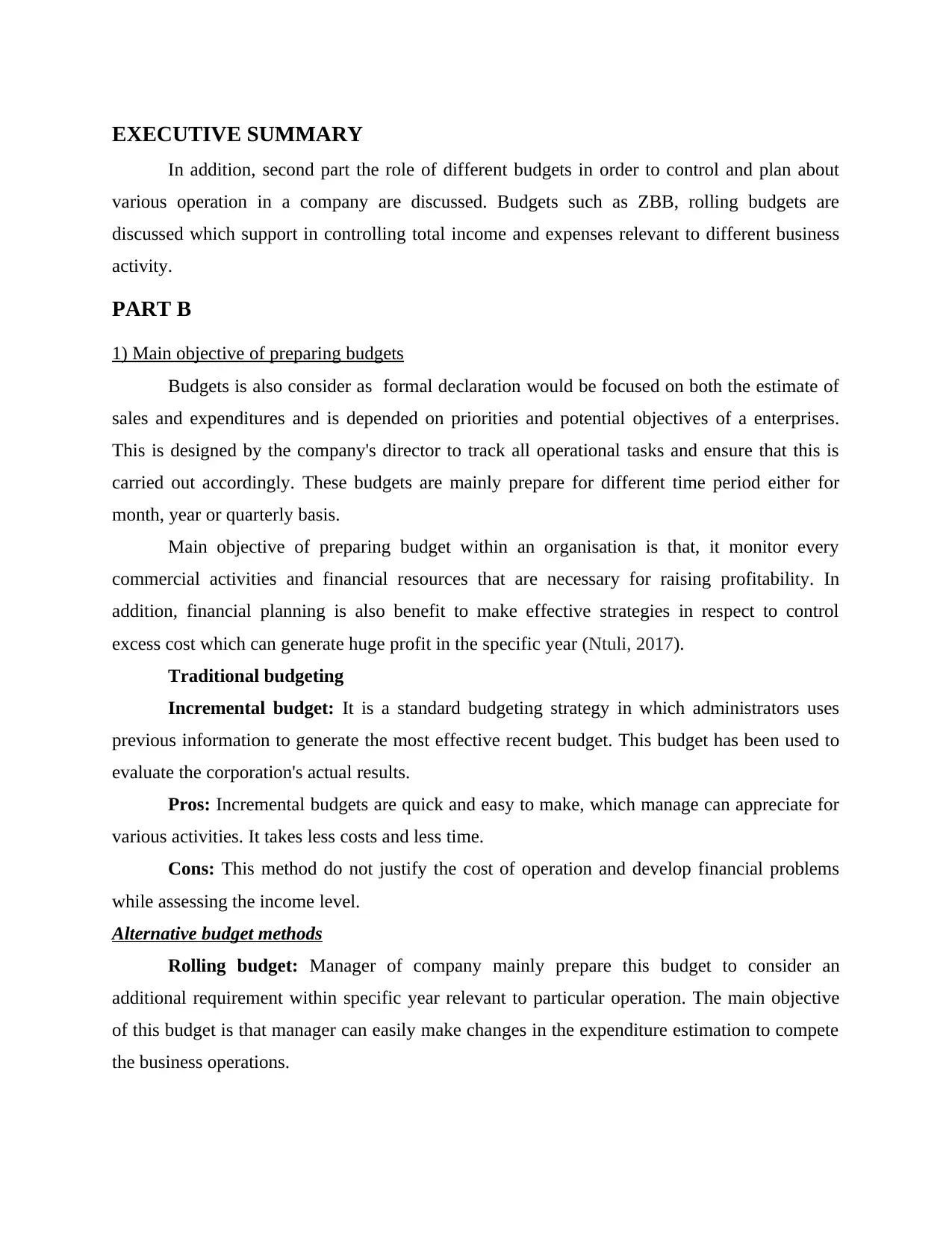
EXECUTIVE SUMMARY
In addition, second part the role of different budgets in order to control and plan about
various operation in a company are discussed. Budgets such as ZBB, rolling budgets are
discussed which support in controlling total income and expenses relevant to different business
activity.
PART B
1) Main objective of preparing budgets
Budgets is also consider as formal declaration would be focused on both the estimate of
sales and expenditures and is depended on priorities and potential objectives of a enterprises.
This is designed by the company's director to track all operational tasks and ensure that this is
carried out accordingly. These budgets are mainly prepare for different time period either for
month, year or quarterly basis.
Main objective of preparing budget within an organisation is that, it monitor every
commercial activities and financial resources that are necessary for raising profitability. In
addition, financial planning is also benefit to make effective strategies in respect to control
excess cost which can generate huge profit in the specific year (Ntuli, 2017).
Traditional budgeting
Incremental budget: It is a standard budgeting strategy in which administrators uses
previous information to generate the most effective recent budget. This budget has been used to
evaluate the corporation's actual results.
Pros: Incremental budgets are quick and easy to make, which manage can appreciate for
various activities. It takes less costs and less time.
Cons: This method do not justify the cost of operation and develop financial problems
while assessing the income level.
Alternative budget methods
Rolling budget: Manager of company mainly prepare this budget to consider an
additional requirement within specific year relevant to particular operation. The main objective
of this budget is that manager can easily make changes in the expenditure estimation to compete
the business operations.
In addition, second part the role of different budgets in order to control and plan about
various operation in a company are discussed. Budgets such as ZBB, rolling budgets are
discussed which support in controlling total income and expenses relevant to different business
activity.
PART B
1) Main objective of preparing budgets
Budgets is also consider as formal declaration would be focused on both the estimate of
sales and expenditures and is depended on priorities and potential objectives of a enterprises.
This is designed by the company's director to track all operational tasks and ensure that this is
carried out accordingly. These budgets are mainly prepare for different time period either for
month, year or quarterly basis.
Main objective of preparing budget within an organisation is that, it monitor every
commercial activities and financial resources that are necessary for raising profitability. In
addition, financial planning is also benefit to make effective strategies in respect to control
excess cost which can generate huge profit in the specific year (Ntuli, 2017).
Traditional budgeting
Incremental budget: It is a standard budgeting strategy in which administrators uses
previous information to generate the most effective recent budget. This budget has been used to
evaluate the corporation's actual results.
Pros: Incremental budgets are quick and easy to make, which manage can appreciate for
various activities. It takes less costs and less time.
Cons: This method do not justify the cost of operation and develop financial problems
while assessing the income level.
Alternative budget methods
Rolling budget: Manager of company mainly prepare this budget to consider an
additional requirement within specific year relevant to particular operation. The main objective
of this budget is that manager can easily make changes in the expenditure estimation to compete
the business operations.
⊘ This is a preview!⊘
Do you want full access?
Subscribe today to unlock all pages.

Trusted by 1+ million students worldwide
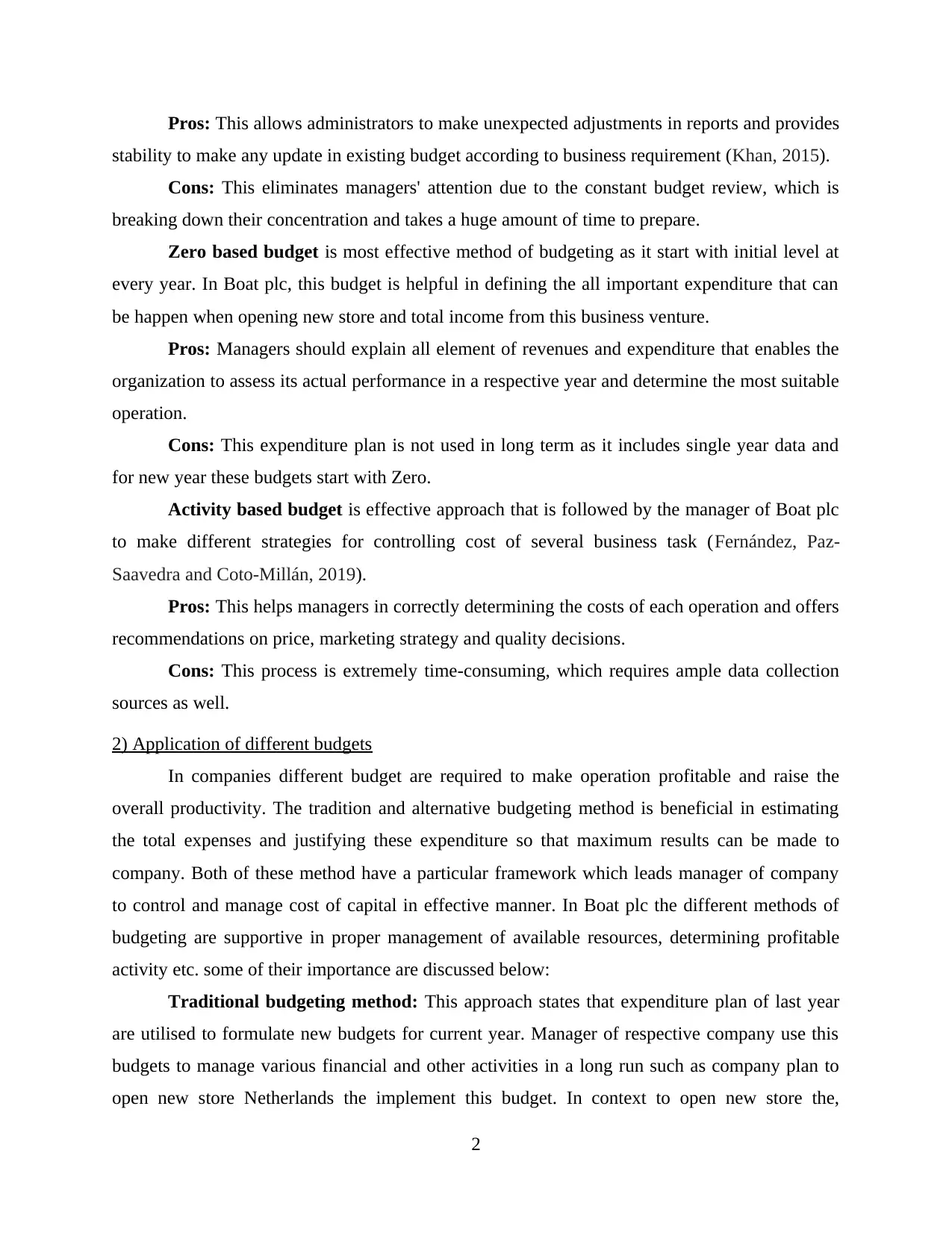
Pros: This allows administrators to make unexpected adjustments in reports and provides
stability to make any update in existing budget according to business requirement (Khan, 2015).
Cons: This eliminates managers' attention due to the constant budget review, which is
breaking down their concentration and takes a huge amount of time to prepare.
Zero based budget is most effective method of budgeting as it start with initial level at
every year. In Boat plc, this budget is helpful in defining the all important expenditure that can
be happen when opening new store and total income from this business venture.
Pros: Managers should explain all element of revenues and expenditure that enables the
organization to assess its actual performance in a respective year and determine the most suitable
operation.
Cons: This expenditure plan is not used in long term as it includes single year data and
for new year these budgets start with Zero.
Activity based budget is effective approach that is followed by the manager of Boat plc
to make different strategies for controlling cost of several business task (Fernández, Paz-
Saavedra and Coto-Millán, 2019).
Pros: This helps managers in correctly determining the costs of each operation and offers
recommendations on price, marketing strategy and quality decisions.
Cons: This process is extremely time-consuming, which requires ample data collection
sources as well.
2) Application of different budgets
In companies different budget are required to make operation profitable and raise the
overall productivity. The tradition and alternative budgeting method is beneficial in estimating
the total expenses and justifying these expenditure so that maximum results can be made to
company. Both of these method have a particular framework which leads manager of company
to control and manage cost of capital in effective manner. In Boat plc the different methods of
budgeting are supportive in proper management of available resources, determining profitable
activity etc. some of their importance are discussed below:
Traditional budgeting method: This approach states that expenditure plan of last year
are utilised to formulate new budgets for current year. Manager of respective company use this
budgets to manage various financial and other activities in a long run such as company plan to
open new store Netherlands the implement this budget. In context to open new store the,
2
stability to make any update in existing budget according to business requirement (Khan, 2015).
Cons: This eliminates managers' attention due to the constant budget review, which is
breaking down their concentration and takes a huge amount of time to prepare.
Zero based budget is most effective method of budgeting as it start with initial level at
every year. In Boat plc, this budget is helpful in defining the all important expenditure that can
be happen when opening new store and total income from this business venture.
Pros: Managers should explain all element of revenues and expenditure that enables the
organization to assess its actual performance in a respective year and determine the most suitable
operation.
Cons: This expenditure plan is not used in long term as it includes single year data and
for new year these budgets start with Zero.
Activity based budget is effective approach that is followed by the manager of Boat plc
to make different strategies for controlling cost of several business task (Fernández, Paz-
Saavedra and Coto-Millán, 2019).
Pros: This helps managers in correctly determining the costs of each operation and offers
recommendations on price, marketing strategy and quality decisions.
Cons: This process is extremely time-consuming, which requires ample data collection
sources as well.
2) Application of different budgets
In companies different budget are required to make operation profitable and raise the
overall productivity. The tradition and alternative budgeting method is beneficial in estimating
the total expenses and justifying these expenditure so that maximum results can be made to
company. Both of these method have a particular framework which leads manager of company
to control and manage cost of capital in effective manner. In Boat plc the different methods of
budgeting are supportive in proper management of available resources, determining profitable
activity etc. some of their importance are discussed below:
Traditional budgeting method: This approach states that expenditure plan of last year
are utilised to formulate new budgets for current year. Manager of respective company use this
budgets to manage various financial and other activities in a long run such as company plan to
open new store Netherlands the implement this budget. In context to open new store the,
2
Paraphrase This Document
Need a fresh take? Get an instant paraphrase of this document with our AI Paraphraser
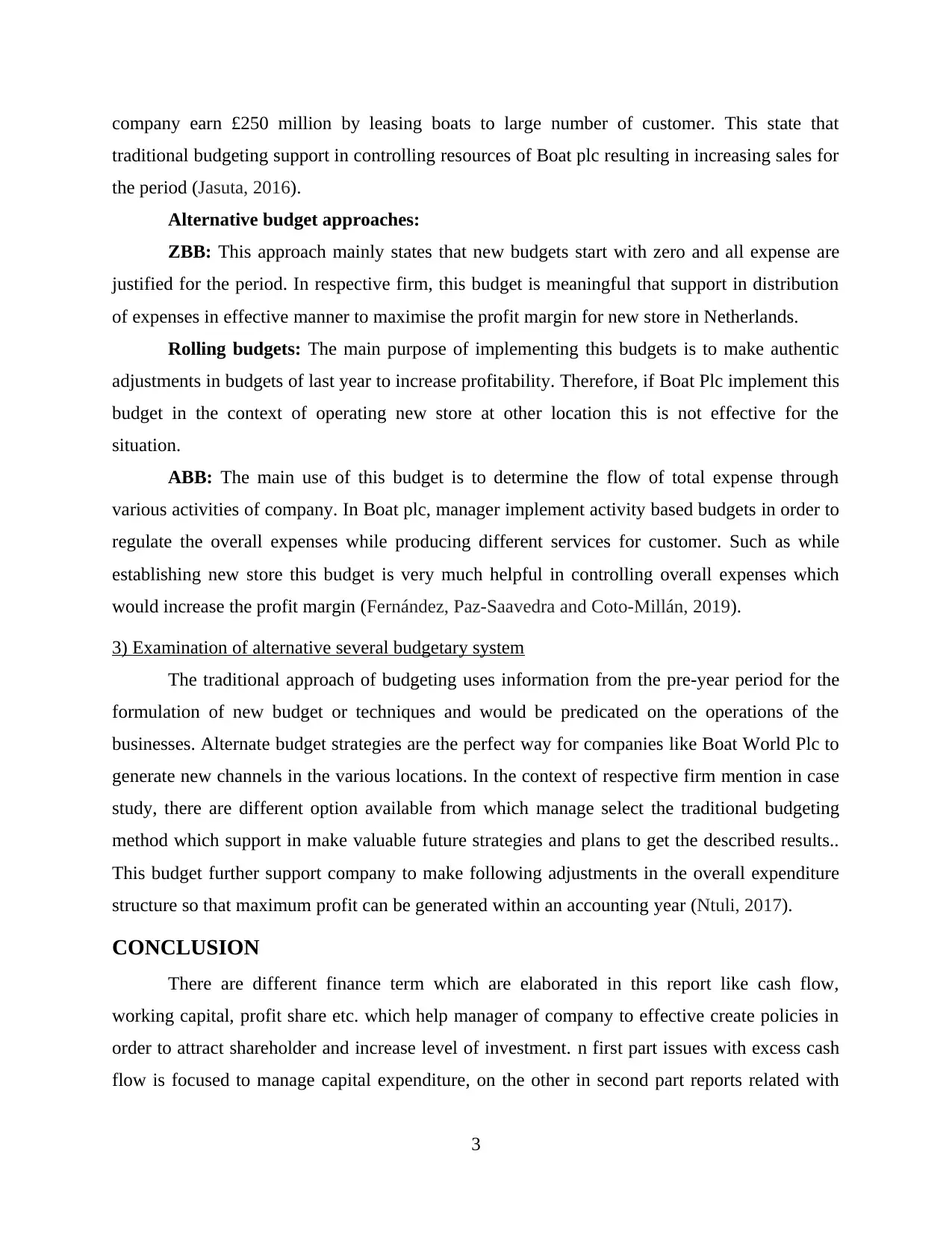
company earn £250 million by leasing boats to large number of customer. This state that
traditional budgeting support in controlling resources of Boat plc resulting in increasing sales for
the period (Jasuta, 2016).
Alternative budget approaches:
ZBB: This approach mainly states that new budgets start with zero and all expense are
justified for the period. In respective firm, this budget is meaningful that support in distribution
of expenses in effective manner to maximise the profit margin for new store in Netherlands.
Rolling budgets: The main purpose of implementing this budgets is to make authentic
adjustments in budgets of last year to increase profitability. Therefore, if Boat Plc implement this
budget in the context of operating new store at other location this is not effective for the
situation.
ABB: The main use of this budget is to determine the flow of total expense through
various activities of company. In Boat plc, manager implement activity based budgets in order to
regulate the overall expenses while producing different services for customer. Such as while
establishing new store this budget is very much helpful in controlling overall expenses which
would increase the profit margin (Fernández, Paz-Saavedra and Coto-Millán, 2019).
3) Examination of alternative several budgetary system
The traditional approach of budgeting uses information from the pre-year period for the
formulation of new budget or techniques and would be predicated on the operations of the
businesses. Alternate budget strategies are the perfect way for companies like Boat World Plc to
generate new channels in the various locations. In the context of respective firm mention in case
study, there are different option available from which manage select the traditional budgeting
method which support in make valuable future strategies and plans to get the described results..
This budget further support company to make following adjustments in the overall expenditure
structure so that maximum profit can be generated within an accounting year (Ntuli, 2017).
CONCLUSION
There are different finance term which are elaborated in this report like cash flow,
working capital, profit share etc. which help manager of company to effective create policies in
order to attract shareholder and increase level of investment. n first part issues with excess cash
flow is focused to manage capital expenditure, on the other in second part reports related with
3
traditional budgeting support in controlling resources of Boat plc resulting in increasing sales for
the period (Jasuta, 2016).
Alternative budget approaches:
ZBB: This approach mainly states that new budgets start with zero and all expense are
justified for the period. In respective firm, this budget is meaningful that support in distribution
of expenses in effective manner to maximise the profit margin for new store in Netherlands.
Rolling budgets: The main purpose of implementing this budgets is to make authentic
adjustments in budgets of last year to increase profitability. Therefore, if Boat Plc implement this
budget in the context of operating new store at other location this is not effective for the
situation.
ABB: The main use of this budget is to determine the flow of total expense through
various activities of company. In Boat plc, manager implement activity based budgets in order to
regulate the overall expenses while producing different services for customer. Such as while
establishing new store this budget is very much helpful in controlling overall expenses which
would increase the profit margin (Fernández, Paz-Saavedra and Coto-Millán, 2019).
3) Examination of alternative several budgetary system
The traditional approach of budgeting uses information from the pre-year period for the
formulation of new budget or techniques and would be predicated on the operations of the
businesses. Alternate budget strategies are the perfect way for companies like Boat World Plc to
generate new channels in the various locations. In the context of respective firm mention in case
study, there are different option available from which manage select the traditional budgeting
method which support in make valuable future strategies and plans to get the described results..
This budget further support company to make following adjustments in the overall expenditure
structure so that maximum profit can be generated within an accounting year (Ntuli, 2017).
CONCLUSION
There are different finance term which are elaborated in this report like cash flow,
working capital, profit share etc. which help manager of company to effective create policies in
order to attract shareholder and increase level of investment. n first part issues with excess cash
flow is focused to manage capital expenditure, on the other in second part reports related with
3
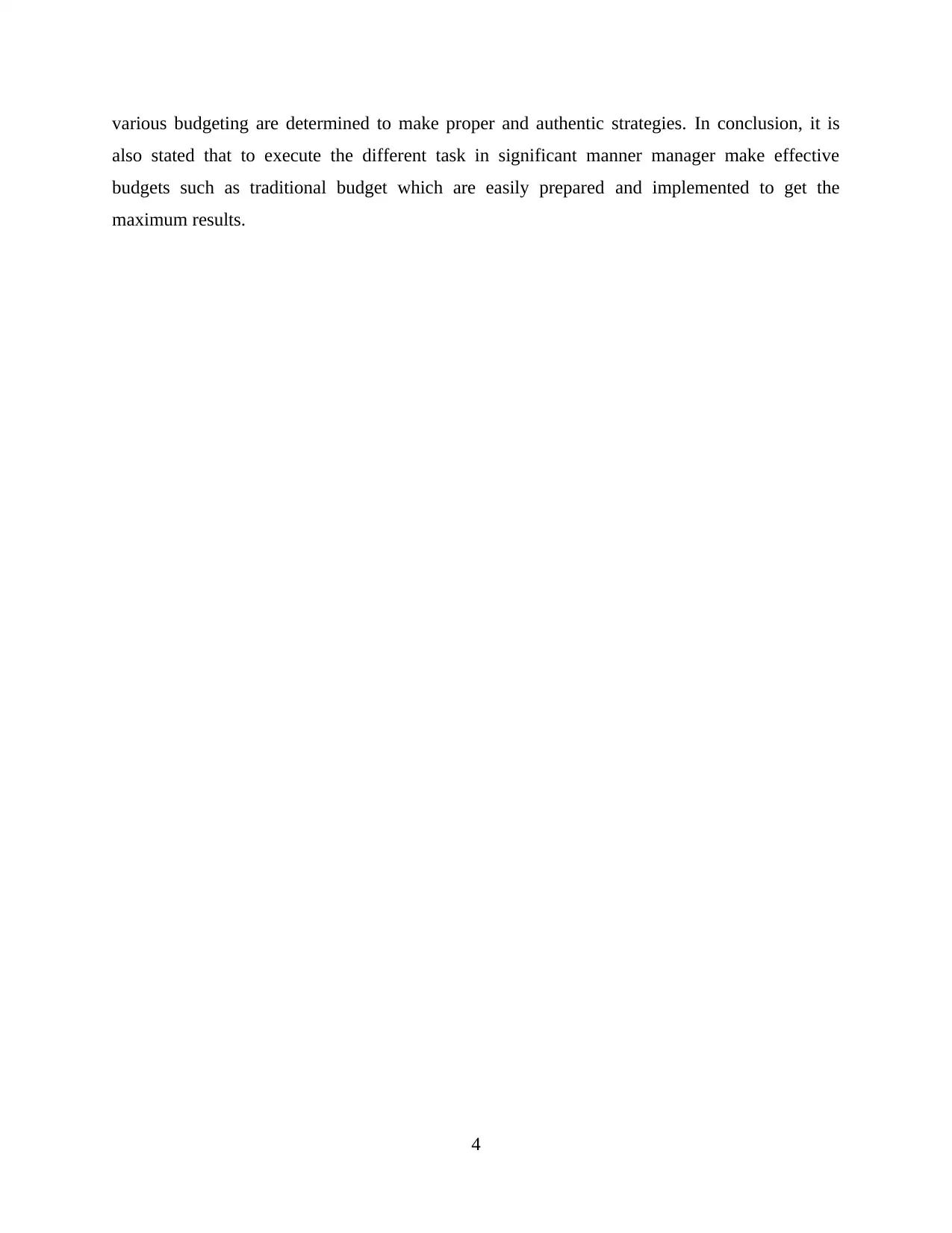
various budgeting are determined to make proper and authentic strategies. In conclusion, it is
also stated that to execute the different task in significant manner manager make effective
budgets such as traditional budget which are easily prepared and implemented to get the
maximum results.
4
also stated that to execute the different task in significant manner manager make effective
budgets such as traditional budget which are easily prepared and implemented to get the
maximum results.
4
⊘ This is a preview!⊘
Do you want full access?
Subscribe today to unlock all pages.

Trusted by 1+ million students worldwide
1 out of 13
Related Documents
Your All-in-One AI-Powered Toolkit for Academic Success.
+13062052269
info@desklib.com
Available 24*7 on WhatsApp / Email
![[object Object]](/_next/static/media/star-bottom.7253800d.svg)
Unlock your academic potential
Copyright © 2020–2025 A2Z Services. All Rights Reserved. Developed and managed by ZUCOL.




